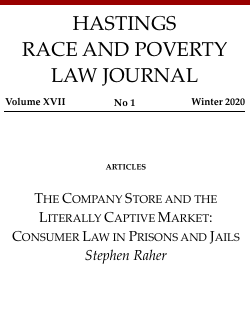The law is supposed to protect consumers from exploitation, but it’s not protecting people in prisons and jails
When the only way to get necessities in prison is to buy them from a single retailer, exploitation is the result.
by Wanda Bertram, November 14, 2019
As John Oliver explained in a recent episode of Last Week Tonight, people in prison are consumers too: Incarcerated people must pay for basic necessities such as phone calls, soap, and medicine, to say nothing of “luxury” items such as books. But how are consumer rights and protections different for people behind bars, and what can be done to protect these consumers from exploitation?
The Hastings Race and Poverty Law Journal has just published an article by Prison Policy Initiative volunteer Stephen Raher, presenting a comprehensive survey of consumer law issues in prisons and jails. Raher will speak about his article, The Company Store and the Literally Captive Market, at this weekend’s Consumer Rights Litigation Conference, sponsored by the National Consumer Law Center. Raher’s article explains:
- How incarcerated consumers are denied basic aspects of customer care – such as refunds for shoddy products, meaningful warranties, or even the expectation that a product will be well made. (pp. 72-76)
- How prison retail companies attempt to justify the high prices they charge incarcerated customers. For instance, prison retailers often claim that high prices are necessary because of the overhead costs associated with security. But these overhead costs — to the extent that they are real–are likely canceled out by common business functions that prison retailers don’t have to spend money on, such as advertising and operating a network of brick-and-mortar stores. (p. 25)
- How prison retail companies have avoided regulation. For instance, some prison phone companies are attempting to brand themselves as “information services” companies, a class of company subject to fewer regulations and less oversight. (p. 52)
- How prisons and jails themselves exacerbate the problem. Not only have a growing number of correctional facilities shifted the costs of incarceration onto incarcerated people (for example, by making people pay for medical supplies or clothing), they also frequently garnish portions of family members’ deposits into their loved ones’ trust accounts, making it even more expensive for people on the outside to support their loved ones. (pp. 81-82)
- What sources of protection are available. Incarcerated people and their family members may have rights under existing laws like the Communications Act, the Electronic Fund Transfer Act, or state consumer-protection statutes. Some activist groups have scored major victories under these laws, but often legal action is impossible or impractical given ubiquitous arbitration clauses and class-action bans that appear in companies’ terms of service. (p. 33)
There are also detailed discussions of data breaches impacting incarcerated people (pp. 40-44), deceptive advertising practices (pp. 36-40), and the rapidly-expanding practice of utilizing computer tablets inside prisons and jails (pp. 21-23).
Historically, there was little need for consumer protection in correctional facilities because the facilities used to provide basic necessities and incarcerated people had little need to engage in commercial transactions. But as more essential goods and services — toothpaste, phone calls, socks, etc. — are accessible only via purchase, people are faced with commercial exploitation while they are incarcerated.
Unfortunately, incarcerated people are uniquely vulnerable because in many segments of American law (like telecommunications), government regulators have taken a hands-off approach under the belief that consumers will choose companies that don’t treat them unfairly, and therefore the market will self-police. This logic has no place in correctional facilities, where phone and commissary vendors enjoy monopoly powers, and consumers have one choice: submit to an unfair transaction, or go without toothpaste or a phone call with family.
The article concludes with eight concrete policy proposals that describe how state and local governments, and federal lawmakers, can take modest but meaningful steps to protect incarcerated people and their families from unfair and oppressive commercial transactions.
The article is long and detailed, so we prepared a table of contents for it with links to the individual sections:
Table of contents
- Background p. 5
- Surveying the Landscape of Prison Retailing p. 9
- End Users p. 9
- Payers p. 10
- Facilities p. 12
- Vendors p. 15
- Unfair Industry Practices p. 23
- Potential Sources of Protection p. 46
- Telecommunications Law p. 46
- Financial Services Law, Money Transmitters, and Prepaid Accounts p. 58
- UDAP Statutes p. 66
- Prices p. 68
- Terms and Conditions p. 70
- Sales of Goods p. 72
- Antitrust p. 75
- Policy Recommendations p. 76
- State and Local Governments p. 77
- Federal p. 83
- Conclusion p. 86




